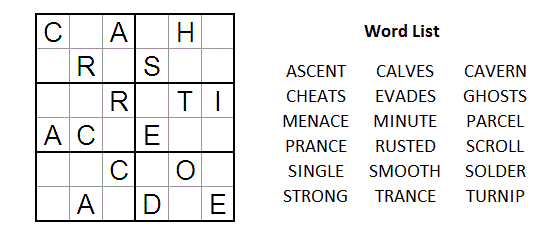This ain’t no Pseudo Ku, this is Real Ku
You’ve all seen Sudoku by now. And if you haven’t, which planet have you been living on since 2005? Sudoku is everywhere. What makes Sudoku so challenging — and so morbidly addictive — is that if you make one mistake, you’re pretty much history. I certainly remember feeling a sense of accomplishment on solving my first “fiendish” Sudoku.
But is it just me, or does Sudoku lack something? In a crossword, new words crop up all the time. You might see a word like OLIGARCHY and think, what a cool word, I should try and use that in next week’s presentation to the board of directors. Sudoku offers none of that. Once you’ve done a few, it dawns on you that you’re putting the same numbers in a grid over and over again, just in a different order.
This is where Lexoku comes in. In a Lexoku puzzle like the one below, you’re given a 6×6 grid — six rows, six columns and six 2×3 blocks. You’re also given a list of words:

The object is to fill the grid by sticking to three simple rules:
1. Every row must contain all the letters of one of the words
2. Every column must contain all the letters of one of the words
3. Every 2×3 block must contain all the letters of one of the words.
All 18 of the words are used once in the grid.
As you can see, you still have to think up, down and sideways, but you get the added variety of words that differ from one puzzle to the next. If you’d like to have a go at solving this puzzle, click here for a printable version.
For some helpful hints in attempting this particular puzzle, and to get a better general idea of how Lexoku works, please click here.
Beware that Lexoku puzzles vary greatly in difficulty. To give you a vague idea of this, I’ve implemented a star rating which ranges from half a star (!) up to five.
Click here for the solution to the puzzle above or have a go at some of these:
If this Ku isn’t real enough for you, for an extra challenge you can also attempt the Jigsaw and Killer variants.







